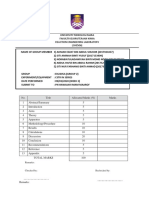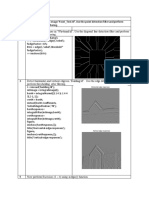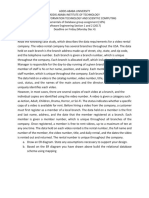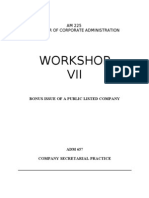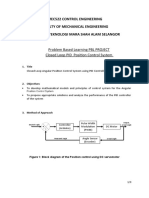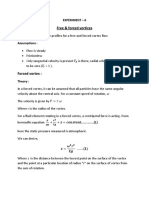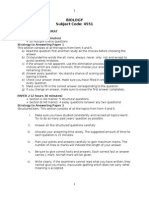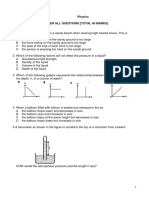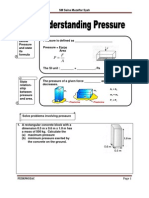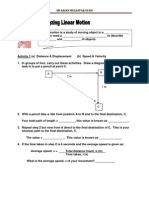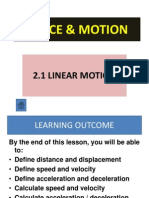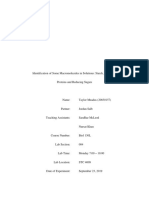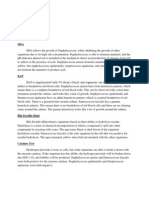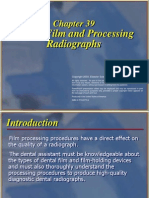Tutorial 3.3
Tutorial 3.3
Uploaded by
cikgusuriyatiCopyright:
Available Formats
Tutorial 3.3
Tutorial 3.3
Uploaded by
cikgusuriyatiOriginal Description:
Copyright
Available Formats
Share this document
Did you find this document useful?
Is this content inappropriate?
Copyright:
Available Formats
Tutorial 3.3
Tutorial 3.3
Uploaded by
cikgusuriyatiCopyright:
Available Formats
TUTORIAL 3.
3 GAS & ATMOSPHERIC PRESSURE
1. Gas pressure exits because the gas molecules A. move randomly and freely B. move at the same velocity C. collide with one another in elastic collisions and with the walls of the container in D. collides with the wall of the container produces change of momentum
2. Which one of the following pairs of measuring instruments to measure gas pressure is true? A. Bourdon gauge and manometer B. Manometer and Fortins barometer C. Bourdon gauge and Fortin barometer D. Fortins barometer Fortin and Aneroid barometer
3. The figure shows a manometer used to determine pressure in a gas tank. Which comparison is correct about pressure in the gas tank with the atmospheric pressure? (2004) A Pressure in the gas tank is equal to the atmospheric pressure B Pressure in the gas tank is greater than the atmospheric pressure C Pressure in the gas tank is less than the atmospheric pressure
4. The figure shows a manometer is connected to a gas supply. If the atmospheric pressure is 76 cm Hg determine the pressure of the gas. A 30 cm Hg B 46 cm Hg C 76 cm Hg D 106 cm Hg
5. We do not experience the atmospheric pressure at sea level because A. the atmospheric is very light B. the density of atmospheric is less than the density of our body C. the force exerted by the atmospheric pressure is zero D. the pressure of our body equal to the atmospheric pressure
6. The figures show a simple mercury barometer. Which one shows the height, h, to be measure to find atmospheric pressure?
7. The figure shows a mercury barometer. What happen to the height of h if the glass tube is tilted ? A decreases B increases C remains unchanged
8. Normally mercury is used in a barometer because it is A expands uniformly B has a higher density C has a higher boiling point D does not stick to the glass tube
9. The figure shows a suction pump being pressed against a smooth wall. The pump sticks to the wall when released. The pump sticks to the wall because . (2005) A the atmospheric pressure is equal to the pressure inside the pump B the atmospheric pressure is less than the pressure inside the pump C the atmospheric pressure is more than the pressure inside the pump
10. A suction pump is pulled upwards to remove dirt from a blocked sink pipe. Which diagram shows the pressures correctly? (2008)
11. The figure shows a mercury barometer What is the pressure at point X? [ The atmospheric pressure = 75 cm Hg ] A 0 cm Hg B 65 cm Hg C 75cm Hg D 85 cm Hg E 100 cm Hg
12. The figure shows a mercury barometer. If the vacuum space in the tube is filled with gas X , what is the pressure of gas X? [ The atmospheric pressure = 75 cm Hg ] A 0 cm Hg B 20 cm Hg C 55 cm Hg D 75 cm Hg E 95 cm Hg
13.Diagram below shows a simple barometer. The difference in height of the two mercury levels is h. What happens to the value of h when mercury is added to the container? (2007) A. Increases B. Decreases C. No change
14. Which of the following situations only occurs due to atmospheric pressure? (2007)
15. Diagram 10 shows a manometer connected to a balloon. What is the pressure, PB, inside the balloon? ( = density of mercury, g = gravitational acceleration, Patm = atmospheric pressure) A. PB = hg B. PB = Patm hg C. PB = Patm + hg
Name the apparatus as shown in the figure. (b) Name the space P.
17. The figure shows an arrangement of apparatus is used to determine the atmospheric pressure in a laboratory. The length of the glass tube is 100 cm and the atmospheric pressure in the lab is 75 cm Hg. (a) Name the apparatus as shown in the figure. Fortin / Mercury Barometer (b) Name the space P. Vaccuum
(c)(i) What is the value of h? 75 cm (ii)Give one reason why dont the mercury column drops until it reaches the level of the mercury in the dish? Support by the atmospheric pressure (d) Determine the pressure in units cm Hg at point (i) J 75 cm Hg (ii) K 75 + 15 = 90 cm Hg
What will happen to the value of h if (i)the tube is raised through a height 10 cm No change (ii) the tube is lowered through a depth of 5 cm No change (ii) the glass tube is inclined about 50 from the vertical line. No change (iv) the surrounding temperature increases. Increase (v) the apparatus is placed on the top of a mountain. decreases (vi)the space P in the tube is filled with the little of water. decrease
(a) Why does the pressure in a plane cabin which fly at a high altitude must be maintained at the atmospheric pressure at the sea level? The pressure in the place cabin must equal to the pressure inside the passengers body which is equal to atmospheric prssure at the sea level. (b)What will happen if one of the plane wind screen broke suddenly? Explain your answer. Everything inside the plane cabin will go out. The pressure inside the cabin is higher than the pressure outside.
You might also like
- Prepared For: Puan Khair Shakira Bustamam Prepared By: Anis Shahireen Effah Atiqah Fatinah Husna Nur FatinDocument9 pagesPrepared For: Puan Khair Shakira Bustamam Prepared By: Anis Shahireen Effah Atiqah Fatinah Husna Nur FatinFatinah Husna100% (2)
- CSTR IN SERIES (Lab Report)Document26 pagesCSTR IN SERIES (Lab Report)Channis ExoNo ratings yet
- QweDocument35 pagesQweLokanayaki Subramaniam0% (1)
- Individual Assignment 5Document3 pagesIndividual Assignment 5Sirak Masresha0% (1)
- 03 AccII Sem03 HandoutDocument2 pages03 AccII Sem03 HandoutGul ZamanNo ratings yet
- Lab 9Document2 pagesLab 9Aina Zhrh0% (1)
- Mueller Experiments Kromrey Brandt Tesla Bedini!!!!!Document30 pagesMueller Experiments Kromrey Brandt Tesla Bedini!!!!!d4nk4r100% (1)
- Bbmp1103 Mathematics For ManagementDocument13 pagesBbmp1103 Mathematics For Managementdicky chongNo ratings yet
- EXPERIMENT 3.3 (New)Document7 pagesEXPERIMENT 3.3 (New)Syasya AziziNo ratings yet
- Exp 7 Spray ChamberDocument8 pagesExp 7 Spray ChamberKinosraj Kumaran100% (1)
- Analysis & Design of E-Community Development System in Jakarta, IndonesiaDocument6 pagesAnalysis & Design of E-Community Development System in Jakarta, IndonesiaArif HandokoNo ratings yet
- CMT 581 Global Warning PresentationDocument26 pagesCMT 581 Global Warning PresentationAlia ShamsuddinNo ratings yet
- Guidelines Apt3083 Case Study (20%) - Converted - Docx GGGGDocument15 pagesGuidelines Apt3083 Case Study (20%) - Converted - Docx GGGGnasrul akimieNo ratings yet
- MAT523 Project PDFDocument4 pagesMAT523 Project PDFMuhd IqbalNo ratings yet
- Group Assignment On ER Case StudyDocument1 pageGroup Assignment On ER Case Studygirmay tadeseNo ratings yet
- REPORT Aida ChocsDocument20 pagesREPORT Aida ChocsAnith Zahirah50% (2)
- Assignment CLB11003Document11 pagesAssignment CLB11003hazry khooNo ratings yet
- Rope Climbing RobotDocument7 pagesRope Climbing RobotSaw Beng KeatNo ratings yet
- Kinematics of Particle: Rectilinear (1D) MotionDocument28 pagesKinematics of Particle: Rectilinear (1D) Motionعبدالرحمن الحازميNo ratings yet
- Engen Soldiers On in Sub-Saharan Africa With SRDC Acquisition A Stellar Performance TH e Merdeka AwardDocument32 pagesEngen Soldiers On in Sub-Saharan Africa With SRDC Acquisition A Stellar Performance TH e Merdeka AwardKapil PunjNo ratings yet
- Lab 1 Cge617Document9 pagesLab 1 Cge617wak syazwanNo ratings yet
- UiTM EVT637 SOLID WASTE PAST YEAR DEC2014 AnswerDocument7 pagesUiTM EVT637 SOLID WASTE PAST YEAR DEC2014 AnswerFadzrilNo ratings yet
- Internship Reflective ReportDocument26 pagesInternship Reflective ReportTan C Chi0% (1)
- Assignment 3Document2 pagesAssignment 3frhslmnNo ratings yet
- Lab 3 Pid MechaDocument29 pagesLab 3 Pid MechaArif Adli HasbullahNo ratings yet
- Lab 4 Logic Gate (Lab Report)Document4 pagesLab 4 Logic Gate (Lab Report)Izzat IkramNo ratings yet
- TJC501 Kaiwa Ujian Simulasi 1Document1 pageTJC501 Kaiwa Ujian Simulasi 1rozahir taichouNo ratings yet
- Bernoulli's TheoremDocument12 pagesBernoulli's TheoremNur Falini Mohd Sukkri100% (3)
- ECS246 Test 1 Sarawak MAC - JUL2022 EndorsedDocument2 pagesECS246 Test 1 Sarawak MAC - JUL2022 EndorsedDEBRA DEIRDRE S. ONONG DEBRA DEIRDRE S. ONONGNo ratings yet
- AmmoniaDocument2 pagesAmmoniaAnonymous ZRez4MBiLNo ratings yet
- Workshop 6 (Students) ADM657Document7 pagesWorkshop 6 (Students) ADM657Khairi N WanieNo ratings yet
- Freezing Out Profit Case StudyDocument7 pagesFreezing Out Profit Case StudySyahrul AmirulNo ratings yet
- Project Proposal TemplateDocument8 pagesProject Proposal TemplateJason ChaiNo ratings yet
- Report EcmDocument8 pagesReport EcmMohamad Khaled NordinNo ratings yet
- Lab 6Document19 pagesLab 6IzzatiHazwaniNo ratings yet
- Presentation Proposal (EWC661)Document9 pagesPresentation Proposal (EWC661)fatin naddNo ratings yet
- Ecw568 Test Question 5 Feb 2021Document4 pagesEcw568 Test Question 5 Feb 2021Syalmira LovetobelovedNo ratings yet
- BMMV1013 Lab 2 20212022 2Document17 pagesBMMV1013 Lab 2 20212022 2Blue BeatleNo ratings yet
- Determination of Riboflavin in Soft Drinks by Fluorescence SpectrophotometryDocument9 pagesDetermination of Riboflavin in Soft Drinks by Fluorescence SpectrophotometryNur IzzatieNo ratings yet
- Mec 291 FlywheelDocument11 pagesMec 291 FlywheelAnas JolailiNo ratings yet
- PBL Technical Report FormatDocument4 pagesPBL Technical Report FormatVinz ChiaNo ratings yet
- Al Kafalah Assignment Ctu 351 PDFDocument16 pagesAl Kafalah Assignment Ctu 351 PDFPiqsamNo ratings yet
- MEC522 PBL - ArduinoDC - MotorEncoder - Close LoopDocument3 pagesMEC522 PBL - ArduinoDC - MotorEncoder - Close Loopzaiful hakimNo ratings yet
- Cost Breakdown AnalysisDocument26 pagesCost Breakdown Analysispriyaa03No ratings yet
- My Final Year Project On Transformer Loss ReductionDocument35 pagesMy Final Year Project On Transformer Loss Reductionabhimishra31100% (6)
- 10 May 2020 Before 5 PM at Author - Uthm.edu - My (I Will Create The Folder To Submit)Document2 pages10 May 2020 Before 5 PM at Author - Uthm.edu - My (I Will Create The Folder To Submit)Sky FireNo ratings yet
- Amended Pyq June 2014 Part C Question 1Document48 pagesAmended Pyq June 2014 Part C Question 1Imran ShahNo ratings yet
- Experiment (7) Free and Forced VortexDocument3 pagesExperiment (7) Free and Forced Vortexmanoj100% (1)
- Mic542 Lab 2Document16 pagesMic542 Lab 2adibaumairahNo ratings yet
- 3b BJT DC AnalysisDocument21 pages3b BJT DC AnalysisKuAdenan KuSyakranNo ratings yet
- Answering TechDocument17 pagesAnswering TechChiYenNo ratings yet
- Experiment 2 Gelling Time and Casting Technique of Thermoset SampleDocument8 pagesExperiment 2 Gelling Time and Casting Technique of Thermoset SamplePeichee Chuar100% (1)
- Steel Project ReportDocument106 pagesSteel Project ReportDanialNo ratings yet
- Evt 4204 Indi AssignDocument8 pagesEvt 4204 Indi AssignHenry TanNo ratings yet
- ACFrOgDvPXMbgn-8KJn3MpIEqU7Ac6nsCWNjLhSoJ9U8NhVwZ56PBEBGQRZVkI8 WrSFP9M yuGJZWe3EiqY5z5ZupkpgRoSyaipeRU9g3Dn21k5S4Nxfmp8TFDJehxlpedHUouBv QGn0geh1fpDocument9 pagesACFrOgDvPXMbgn-8KJn3MpIEqU7Ac6nsCWNjLhSoJ9U8NhVwZ56PBEBGQRZVkI8 WrSFP9M yuGJZWe3EiqY5z5ZupkpgRoSyaipeRU9g3Dn21k5S4Nxfmp8TFDJehxlpedHUouBv QGn0geh1fpSYAZANA FIRAS SAMATNo ratings yet
- ELC231 Course Info Dated1 31052016Document5 pagesELC231 Course Info Dated1 31052016norNo ratings yet
- Measure of Pump Efficiency, Head and DischargeDocument15 pagesMeasure of Pump Efficiency, Head and DischargeHaikal HarithNo ratings yet
- Ethics ReportDocument6 pagesEthics ReportNur AqilahNo ratings yet
- Tutorial 3.3: Gas & Atmospheric PressureDocument20 pagesTutorial 3.3: Gas & Atmospheric PressurePauling ChiaNo ratings yet
- Physics Y10 Term 2 Exam Paper1 EditedDocument10 pagesPhysics Y10 Term 2 Exam Paper1 EditedUswa ChNo ratings yet
- Physics Y10 Term 2 Exam Paper1 EditedDocument10 pagesPhysics Y10 Term 2 Exam Paper1 EditedEzra Loganathan MuniandiNo ratings yet
- 3.3 Atmospheric and Gas Pressure 2012Document12 pages3.3 Atmospheric and Gas Pressure 2012cikgusuriyati100% (1)
- 3.4 Pascal Principal IntensiveDocument33 pages3.4 Pascal Principal Intensivecikgusuriyati100% (1)
- Tutorial 3.2Document22 pagesTutorial 3.2cikgusuriyatiNo ratings yet
- 3.1 Pressure 2012Document7 pages3.1 Pressure 2012cikgusuriyati50% (2)
- 3.2 Liquid Pressure IntensiveDocument22 pages3.2 Liquid Pressure IntensivecikgusuriyatiNo ratings yet
- 3.2 Liquid Pressure 2012Document12 pages3.2 Liquid Pressure 2012cikgusuriyati100% (1)
- Tutorial 3.1Document13 pagesTutorial 3.1cikgusuriyatiNo ratings yet
- Paper 2 Section B and C Sample QuestionsDocument30 pagesPaper 2 Section B and C Sample Questionscikgusuriyati100% (4)
- Perfec Score Melaka 2012 JawapanDocument11 pagesPerfec Score Melaka 2012 JawapancikgusuriyatiNo ratings yet
- Perfec Score MelakaDocument8 pagesPerfec Score MelakacikgusuriyatiNo ratings yet
- Brochurer ESBDocument4 pagesBrochurer ESBcikgusuriyatiNo ratings yet
- 2.1 Linear Motion 2012Document18 pages2.1 Linear Motion 2012cikgusuriyatiNo ratings yet
- 2.1 Linear MotionDocument66 pages2.1 Linear Motioncikgusuriyati100% (1)
- P.K.Metha CONCRETE - Microstructure Properties and Materials - 34Document1 pageP.K.Metha CONCRETE - Microstructure Properties and Materials - 34Eng.Hesham AL-HelaleeNo ratings yet
- Lab Report 1Document8 pagesLab Report 1TaylorNo ratings yet
- Pneumatic Controller 45P Pss 2b-1h1e-ENDocument16 pagesPneumatic Controller 45P Pss 2b-1h1e-ENjuan alvaradoNo ratings yet
- Chapter 2 The Gaseous StateDocument3 pagesChapter 2 The Gaseous StateChai LianNo ratings yet
- Staph and Strep Lab Report BMS 501Document2 pagesStaph and Strep Lab Report BMS 501aruiz93No ratings yet
- Electrical Discharge Machining of Al 6351 SiC B4C Hybrid CompositeDocument7 pagesElectrical Discharge Machining of Al 6351 SiC B4C Hybrid CompositeAnonymous EU3yPnqvNo ratings yet
- ME4253 Biomat Eng 0 - Overview-2Document7 pagesME4253 Biomat Eng 0 - Overview-2shellyp4No ratings yet
- Filler Metals For The Nuclear Industry (EN)Document8 pagesFiller Metals For The Nuclear Industry (EN)Khaled FatnassiNo ratings yet
- Layna Samuelsen - Research Paper 2018-2019 1Document4 pagesLayna Samuelsen - Research Paper 2018-2019 1api-447857922No ratings yet
- 5.6.1.42. TonometroDocument2 pages5.6.1.42. Tonometrosandra rodriguezNo ratings yet
- LAB Brochure - May2016Document20 pagesLAB Brochure - May2016Majed Dawa100% (1)
- Ammonia Material BalanceDocument7 pagesAmmonia Material BalanceSiva KumarNo ratings yet
- Dental Film and Processing RadiographsDocument58 pagesDental Film and Processing RadiographsNoufalNo ratings yet
- From Molten Materials To RocksDocument3 pagesFrom Molten Materials To RocksDanica Banatao Attaban100% (1)
- Fertilizer ProclamationDocument9 pagesFertilizer ProclamationErmiyas TadesseNo ratings yet
- PRES TIG Hot Wire Narrow Gap Welding enDocument25 pagesPRES TIG Hot Wire Narrow Gap Welding enRavishankarNo ratings yet
- Solubility - Mygdalin - Ethanol + WaterDocument17 pagesSolubility - Mygdalin - Ethanol + WaterDanielRicardoDelgadoNo ratings yet
- Rolling Bearing Analysis Calculation Method: ISO 281:2007 Und Herstellerangaben - With Modified Bearing Service Life According To ISO 281:2007Document2 pagesRolling Bearing Analysis Calculation Method: ISO 281:2007 Und Herstellerangaben - With Modified Bearing Service Life According To ISO 281:2007Santosh Kumar ReddyNo ratings yet
- EN 12732-OtklDocument49 pagesEN 12732-OtklZafiro Avet0% (1)
- Chemicals Used For Cleaning & Manual Cleaning Processes - FINAL 2Document45 pagesChemicals Used For Cleaning & Manual Cleaning Processes - FINAL 2jerimiah_manzon100% (1)
- D244Document8 pagesD244samuelNo ratings yet
- Technical Manual Fire Resistant DuctworkDocument24 pagesTechnical Manual Fire Resistant DuctworkHakan GölcüoğluNo ratings yet
- Transformer CastingDocument10 pagesTransformer CastingJanmejaya MishraNo ratings yet
- IRJET-V7I51387-Effect of Micropile On Foundation SettlementDocument4 pagesIRJET-V7I51387-Effect of Micropile On Foundation SettlementDevesh Kumar PandeyNo ratings yet
- Rheology - My Way of Life: O. H. Wallevik, Reykjavik University & Innovation Center IcelandDocument13 pagesRheology - My Way of Life: O. H. Wallevik, Reykjavik University & Innovation Center IcelandBatepola BacNo ratings yet
- Seismic StudentDocument67 pagesSeismic Studentapi-3700706100% (5)
- All ActivitiesDocument43 pagesAll ActivitiesfanusNo ratings yet
- Boiler Chemistry v.1Document4 pagesBoiler Chemistry v.1Raymond Roy Ocariza ArantonNo ratings yet
- Production of CumeneDocument16 pagesProduction of CumeneSaidNo ratings yet

